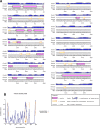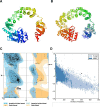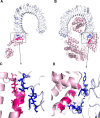In-silico design of a multi-epitope vaccine candidate against onchocerciasis and related filarial diseases
- PMID: 30867498
- PMCID: PMC6416346
- DOI: 10.1038/s41598-019-40833-x
In-silico design of a multi-epitope vaccine candidate against onchocerciasis and related filarial diseases
Abstract
Onchocerciasis is a parasitic disease with high socio-economic burden particularly in sub-Saharan Africa. The elimination plan for this disease has faced numerous challenges. A multi-epitope prophylactic/therapeutic vaccine targeting the infective L3 and microfilaria stages of the parasite's life cycle would be invaluable to achieve the current elimination goal. There are several observations that make the possibility of developing a vaccine against this disease likely. For example, despite being exposed to high transmission rates of infection, 1 to 5% of people have no clinical manifestations of the disease and are thus considered as putatively immune individuals. An immuno-informatics approach was applied to design a filarial multi-epitope subunit vaccine peptide consisting of linear B-cell and T-cell epitopes of proteins reported to be potential novel vaccine candidates. Conservation of the selected proteins and predicted epitopes in other parasitic nematode species suggests that the generated chimera could be helpful for cross-protection. The 3D structure was predicted, refined, and validated using bioinformatics tools. Protein-protein docking of the chimeric vaccine peptide with the TLR4 protein predicted efficient binding. Immune simulation predicted significantly high levels of IgG1, T-helper, T-cytotoxic cells, INF-γ, and IL-2. Overall, the constructed recombinant putative peptide demonstrated antigenicity superior to current vaccine candidates.
Conflict of interest statement
The authors declare no competing interests.
Figures







Similar articles
-
Immuno-informatics Analysis to Identify Novel Vaccine Candidates and Design of a Multi-Epitope Based Vaccine Candidate Against Theileria parasites.Front Immunol. 2018 Oct 15;9:2213. doi: 10.3389/fimmu.2018.02213. eCollection 2018. Front Immunol. 2018. PMID: 30374343 Free PMC article.
-
Designing and comparative analysis of anti-oxidant and heat shock proteins based multi-epitopic filarial vaccines.BMC Infect Dis. 2024 Dec 18;24(1):1436. doi: 10.1186/s12879-024-10272-9. BMC Infect Dis. 2024. PMID: 39695454 Free PMC article.
-
Computational Design and Preliminary Serological Analysis of a Novel Multi-Epitope Vaccine Candidate against Onchocerciasis and Related Filarial Diseases.Pathogens. 2021 Jan 21;10(2):99. doi: 10.3390/pathogens10020099. Pathogens. 2021. PMID: 33494344 Free PMC article.
-
In-silico development of multi-epitope subunit vaccine against lymphatic filariasis.J Biomol Struct Dyn. 2025 Apr;43(6):3016-3030. doi: 10.1080/07391102.2023.2294838. Epub 2023 Dec 20. J Biomol Struct Dyn. 2025. PMID: 38117103 Review.
-
An overview of in silico vaccine design against different pathogens and cancer.Expert Rev Vaccines. 2020 Aug;19(8):699-726. doi: 10.1080/14760584.2020.1794832. Epub 2020 Aug 10. Expert Rev Vaccines. 2020. PMID: 32648830 Review.
Cited by
-
Identification of potential candidate vaccines against Mycobacterium ulcerans based on the major facilitator superfamily transporter protein.Front Immunol. 2022 Nov 8;13:1023558. doi: 10.3389/fimmu.2022.1023558. eCollection 2022. Front Immunol. 2022. PMID: 36426350 Free PMC article.
-
In silico design of a promiscuous chimeric multi-epitope vaccine against Mycobacterium tuberculosis.Comput Struct Biotechnol J. 2023 Jan 16;21:991-1004. doi: 10.1016/j.csbj.2023.01.019. eCollection 2023. Comput Struct Biotechnol J. 2023. PMID: 36733703 Free PMC article.
-
Peptide-Based Vaccines for Tuberculosis.Front Immunol. 2022 Jan 31;13:830497. doi: 10.3389/fimmu.2022.830497. eCollection 2022. Front Immunol. 2022. PMID: 35173740 Free PMC article. Review.
-
Pan-Genome Analysis of Oral Bacterial Pathogens to Predict a Potential Novel Multi-Epitopes Vaccine Candidate.Int J Environ Res Public Health. 2022 Jul 9;19(14):8408. doi: 10.3390/ijerph19148408. Int J Environ Res Public Health. 2022. PMID: 35886259 Free PMC article.
-
Multi-epitope vaccine candidates based on mycobacterial membrane protein large (MmpL) proteins against Mycobacterium ulcerans.Open Biol. 2023 Nov;13(11):230330. doi: 10.1098/rsob.230330. Epub 2023 Nov 8. Open Biol. 2023. PMID: 37935359 Free PMC article.
References
-
- Vlaminck J, Fischer PU, Weil GJ. Diagnostic Tools for Onchocerciasis Elimination Programs. Trends Parasitol. 2015;31:571–82. - PubMed
-
- Pion SD, Kamgno J, Demanga N, Boussinesq M. Excess mortality associated with blindness in the onchocerciasis focus of the Mbam Valley, Cameroon. Ann Trop Med Parasitol. 2002;96:181–9. - PubMed
Publication types
MeSH terms
Substances
LinkOut - more resources
Full Text Sources

